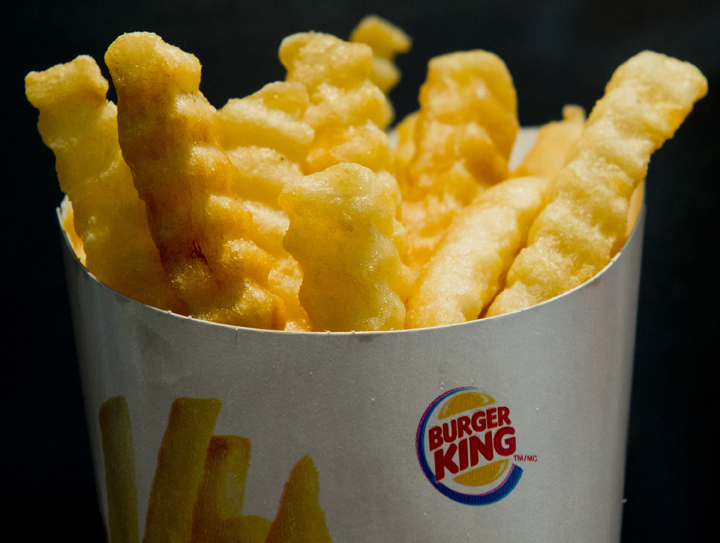TORONTO – It was a busy year for consumers, their dinner tables, treadmills and their waistlines. There was the good (bidding farewell to trans fat), the adorable (Sesame Street characters are slated to promote fruits and veggies to kids) and the ugly (mass Cronut burger food poisoning, anyone?).

Global News health reporter Carmen Chai takes a look at 10 of the most popular health and nutrition stories of the year:
From Cronuts…: So, there was this fad that originated out of a New York City bakery in which a croissant-like “laminated” dough was shaped into a donut, and then fried and glazed like a donut. It was called a Cronut, and it’s allegedly the “most virally talked about dessert item in history,” according to its makers. Yes, there were real lineups around NYC for the Cronut, and the next part of this story is true, too:
In August, a food stall at Toronto’s Canadian National Exhibition concocted the Cronut Burger – the “part croissant, part donut, all epic” meal had an all-beef patty, maple bacon jam and cheese, and was smothered in cinnamon sugar. Some people even added fried eggs and bacon to their burgers.
That opening weekend, close to 100 people reportedly became sick after eating the burger. The culprit? Health officials blamed the bacon maple jam.
READ MORE: Year in Review: 5 health care blunders
…To Satisfries: To counterbalance all the bad in the fast food universe, in September, Burger King introduced Satisfries: a new crinkle cut fry with 40 per cent less fat and 30 per cent fewer calories, a spawn of its fatty, oily spud brother. A small order has 270 calories compared to 340 calories.
Sesame Street peddling fruits and veggies to kids: there is perhaps no one in this world more persuasive than Elmo and his clique. A trip down the grocery store aisle (in the United States for now) could soon feel like a leisurely stroll down Sesame Street.
READ MORE: Cartoon characters key to influencing kids to eat healthier, studies show
In October, First Lady Michelle Obama announced that the TV program will let the produce industry use the likes of Elmo, Big Bird and Oscar the Grouch free of charge to market fresh produce to kids.

Get weekly health news
They’ll be on standalone signs, on stickers and labels on all kinds of fresh fare. Studies have already linked the cartoon characters to influencing kids to eat healthier. The big question: is Cookie Monster on board with this branding?
Bye, bye trans fat: It’s found in deep-fried foods, frozen goods and packaged products, but the Food and Drug Administration in the U.S. said good riddance to trans fat in November, banning the solid fat from the country’s pantry.
Trans fat, meant to make food tasty and stay fresh – is made when a liquid vegetable oil is changed into solid fat – the FDA says the ban could prevent 20,000 heart attacks and 7,000 deaths each year.
It’s in cookies, cakes, frozen pies, microwave popcorn, frozen pizzas, margarines, vegetable shortenings, refrigerated dough products and other goods.
What does this change mean for Canada? READ MORE: Will a U.S. proposal to ban trans fat affect Canadian consumers?
Know your food: Unless your motto is “Ignorance is bliss,” you know most fast food and processed meals aren’t the best for you. But this year, scientists were breaking down nutrition, carefully dissecting what goes into our mouths each day. Do you eat chicken nuggets, Nutella or deep fried Mars bars? If so, cover your eyes and scroll down to the next section.
A U.S. researcher’s study on chicken nuggets suggests that it’s not all white meat. Maybe 50 per cent of it is, but the rest is fat, skin, connective tissue, blood vessels, nerves and bone fragment.
Using the nutrition facts label of Nutella, a Canadian doctor found that the chocolate spread has 5.5 teaspoons of sugar in two tablespoons.
Tens of thousands of Canadians joined a U.S. movement, urging Kraft Foods to remove the controversial dyes that colour the mac and cheese dish a glowing orange.
Meanwhile, a Scottish study on deep fried Mars bars and their effect on blood flow is in the works.
A McDonald’s “Our Food. Your Questions” campaign called on diners to ask the fast food giant anything they wanted. Among the popular questions: How is it that a burger does not rot? Are your fries made out of plastic? And do you use pink slime?
Menus with calories: Some Canadians could soon head to a restaurant in Ontario, open their menus and find out just how many calories are in their enchilada dinner, or even worse, Caesar salad.
In October, the Ontario government promised to introduce legislation that would force restaurants to put calories and other nutritional information on their menus and menu boards. It’s already picked up steam in the U.S. The trouble is, seeing the caloric-damage on the dinner table didn’t scare two-thirds of Americans, studies reported.
Angelina Jolie and breast cancer: In May, Angelina Jolie turned the touchy subject of breast cancer and mastectomies into a household conversation. The Oscar-winning actress announced that she had a double mastectomy – she was carrying a gene mutation called BRCA1 that significantly increases her risk of breast cancer.
READ MORE: Breast cancer and genetics: Angelina Jolie’s double mastectomy
The gene is a rarity, but if women have the harmful BRCA mutation, it can increase the odds of breast cancer by five times. The average woman has an 11 per cent risk of breast cancer, but if she has one of these harmful genes, the risk increases by 80 per cent. After this story, breast cancer screening and awareness was thrown into the spotlight.
The easy way out: Maybe you don’t really want to give up drinking. That’s hard. Scientists know that, and they’re looking out for you, bro: do you want alcohol without the hangover? How about gorging on food all day and then vacuuming the food out of your stomach before the meal is digested? Those two inventions are in the works. Here’s looking at you, all you can eat buffet.
Daddy and diet: This year, daddies-to-be took more heat about their diets and lifestyle than expectant moms. Paternal health and its effects on baby is a burgeoning field of study to watch. For starters, Harvard’s School of Public Health suggested that eating a single piece of certain processed meats like bacon or sausage each day can damage a man’s fertility. It’s just one in a series of studies now looking at what hurts male fertility and sperm quality.
A new Canadian study even suggested that a father’s diet pre-conception plays an equally important role in the health of baby. Sorry, fellas.
Obesity is a real disease: It was a contentious move, but the American Medical Association in June recognized obesity as an official disease. This declaration adds pressure on health officials around the world to rethink the way obesity is approached – medicalizing the disease could change the way doctors treat patients, what insurance covers and even services available to the public.
READ MORE: What one woman in Gabon taught doctors about global obesity
Obesity may be multiplying across North America, but this is a global pandemic: it’s gripping much of the developing world – regions like China, India, Mexico, Brazil, much of the Middle East and South Africa, where global citizens are switching from physical labour to sedentary jobs. Meanwhile, fast food corporations are swiftly tapping into new markets, offering consumers a plethora of food they haven’t had access to before.
carmen.chai@globalnews.ca
Follow @Carmen_Chai









Comments